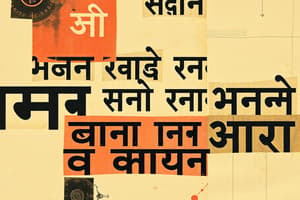Podcast
Questions and Answers
What direction is the Devanagari script written in?
What direction is the Devanagari script written in?
Left to right, top to bottom
What order does the Devanagari script follow for consonants and vowels?
What order does the Devanagari script follow for consonants and vowels?
Consonant-Vowel Order (CV)
What is one significant change in the modern Devanagari script for better readability?
What is one significant change in the modern Devanagari script for better readability?
Proportional spacing
How has Devanagari evolved to meet the needs of modern languages?
How has Devanagari evolved to meet the needs of modern languages?
What technological advancement has allowed Devanagari to be used on computers?
What technological advancement has allowed Devanagari to be used on computers?
What languages, besides Hindi, use the Devanagari script?
What languages, besides Hindi, use the Devanagari script?
What is the primary script in which Hindi is written?
What is the primary script in which Hindi is written?
What does 'Devanagari' mean?
What does 'Devanagari' mean?
Where did the Devanagari script originate from?
Where did the Devanagari script originate from?
What region in India saw the development of the Devanagari script?
What region in India saw the development of the Devanagari script?
How are Devanagari characters formed?
How are Devanagari characters formed?
What unique feature of Devanagari script is used to indicate the pronunciation of consonant clusters?
What unique feature of Devanagari script is used to indicate the pronunciation of consonant clusters?
Flashcards are hidden until you start studying
Study Notes
The World of Hindi: Exploring its Script
Hindi is an ancient Indo-Aryan language, spoken by over 610 million people worldwide and serving as the official language in India and Nepal. A substantial part of the Hindi-speaking population is also based in Fiji, Mauritius, and other countries with Indian diaspora. This comprehensive guide will delve into the unique script that Hindi employs, shedding light on its history, structure, and evolution.
The Origin of Devanagari Script
Hindi is primarily written in the Devanagari script, which originated from the Brahmi script around the 1st century BCE. Devanagari, meaning "the script of the gods," is a highly structured alphabet, with its roots traceable to ancient Indian civilization. The Devanagari script was developed in the Deccan region of India and subsequently spread throughout the Indian subcontinent.
Key Features of Devanagari Script
The Devanagari script has several unique features that distinguish it from other scripts.
-
Ascending and Descending Strokes: Devanagari characters are formed through a combination of ascending and descending strokes, creating a visually balanced and harmonious appearance.
-
Diacritics and Vowel Signs: Unlike the Roman alphabet, Devanagari employs diacritics and vowel signs to indicate the pronunciation of consonant clusters.
-
Directionality: The script is written from left to right, top to bottom, and from right to left on occasion, as in the case of compounds and certain compound words.
-
Consonant-Vowel Order: The Devanagari script follows the consonant-vowel order (CV) system. Consonants are written first, followed by vowel signs that attach to the consonant's base.
The Evolution of Devanagari Script
Over time, the Devanagari script has undergone considerable changes to suit the needs of modern Hindi and other languages using this script, including Marathi, Nepali, and many others.
-
Proportional Spacing: The modern Devanagari script utilizes proportional spacing to ensure better readability and consistency.
-
Extra Characters and Punctuation: Devanagari has evolved to include extra characters and punctuation marks to cater to the needs of modern Hindi and other languages.
-
Computer Encoding and Incorporation: The Devanagari script has been successfully encoded for use on computers, allowing for seamless integration into digital platforms and communication technologies.
Conclusion
The Devanagari script is an essential element of the Hindi language, adding complexity and beauty to its written form. It has undergone significant evolution over time, adapting to the changing needs of modern Hindi and other languages. The Devanagari script remains a testament to the Indian civilization's rich heritage, cultural identity, and innovative spirit, continuing to shape the way Hindi and other languages are written, read, and understood.
Studying That Suits You
Use AI to generate personalized quizzes and flashcards to suit your learning preferences.




